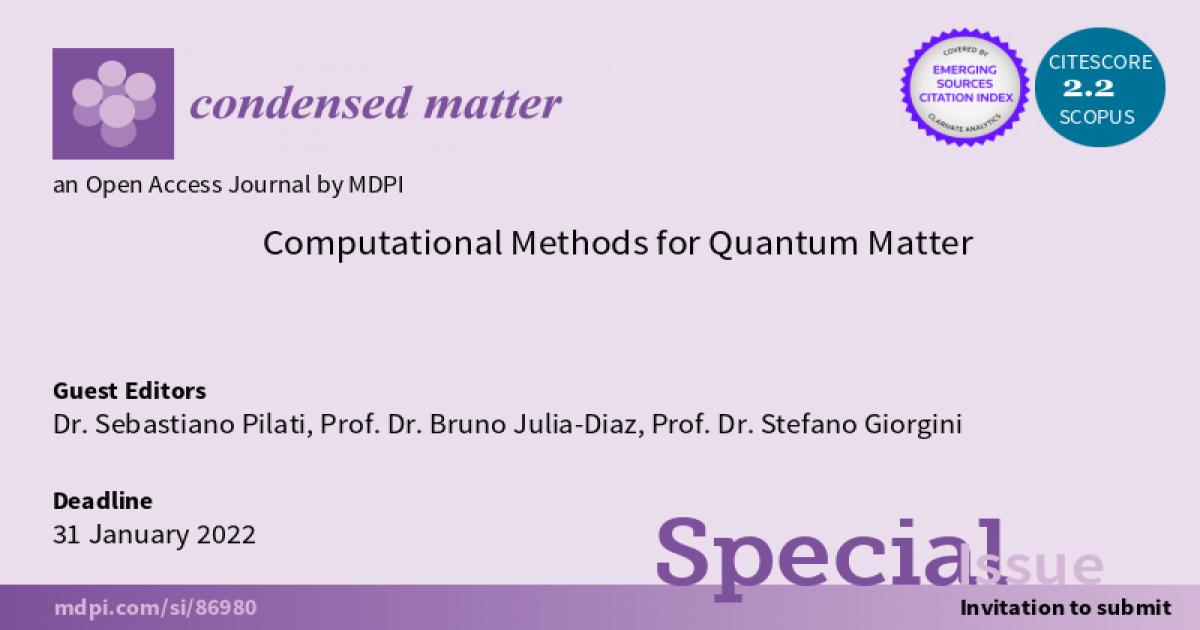Computational Methods for Quantum Matter
A special issue of Condensed Matter (ISSN 2410-3896). This special issue belongs to the section "Quantum Materials".
Deadline for manuscript submissions: closed (31 January 2022) | Viewed by 30725

Special Issue Editors
Interests: ultracold atoms; computational physics
Interests: ultracold clouds
Special Issue Information
Dear Colleagues,
In recent years, remarkable experimental breakthroughs achieved with platforms such as atomic gases, trapped ions, and superconducting qubits have allowed for controlled realizations of various intriguing quantum phenomena. These experiments represent the ideal venue to test novel computational methods for quantum many-body systems. Indeed, various computational frameworks are being developed beyond the state of the art, including, among others: quantum Monte Carlo algorithms, diagrammatic expansions, exact-diagonalization computations, tensor network methods, and density functional theories. Furthermore, machine learning models, e.g., deep neural networks, are currently being imported into the domain of quantum simulations.
This Special Issue aims to showcase relevant computational studies on quantum matter, highlighting successful applications, recent algorithmic advancements, and also the main open challenges. Contributing authors are invited to elucidate physics insights provided by the employed computational techniques and/or to describe enabling technical developments. The further goals are also to provide the community with helpful information for future computational advancements and to bring the open challenges to be addressed by quantum many-body physicists in the near and the midterm future into the spotlight.
Dr. Sebastiano Pilati
Prof. Dr. Bruno Julia-Diaz
Prof. Dr. Stefano Giorgini
Guest Editors
Manuscript Submission Information
Manuscripts should be submitted online at www.mdpi.com by registering and logging in to this website. Once you are registered, click here to go to the submission form. Manuscripts can be submitted until the deadline. All submissions that pass pre-check are peer-reviewed. Accepted papers will be published continuously in the journal (as soon as accepted) and will be listed together on the special issue website. Research articles, review articles as well as short communications are invited. For planned papers, a title and short abstract (about 100 words) can be sent to the Editorial Office for announcement on this website.
Submitted manuscripts should not have been published previously, nor be under consideration for publication elsewhere (except conference proceedings papers). All manuscripts are thoroughly refereed through a single-blind peer-review process. A guide for authors and other relevant information for submission of manuscripts is available on the Instructions for Authors page. Condensed Matter is an international peer-reviewed open access quarterly journal published by MDPI.
Please visit the Instructions for Authors page before submitting a manuscript. The Article Processing Charge (APC) for publication in this open access journal is 1600 CHF (Swiss Francs). Submitted papers should be well formatted and use good English. Authors may use MDPI's English editing service prior to publication or during author revisions.
Benefits of Publishing in a Special Issue
- Ease of navigation: Grouping papers by topic helps scholars navigate broad scope journals more efficiently.
- Greater discoverability: Special Issues support the reach and impact of scientific research. Articles in Special Issues are more discoverable and cited more frequently.
- Expansion of research network: Special Issues facilitate connections among authors, fostering scientific collaborations.
- External promotion: Articles in Special Issues are often promoted through the journal's social media, increasing their visibility.
- e-Book format: Special Issues with more than 10 articles can be published as dedicated e-books, ensuring wide and rapid dissemination.
Further information on MDPI's Special Issue polices can be found here.





